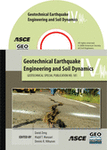Comparison of Panama Wharf Performance Using Numerical Analysis and Limit Equilibrium Methods
Publication: Geotechnical Earthquake Engineering and Soil Dynamics IV
Abstract
Evaluation of the performance of pile supported wharf structures under seismic conditions has evolved in recent years through the use of numerical analysis programs (for example, PLAXIS and FLAC). Before the use of numerical analysis programs, the performance of a pile supported wharf structure was evaluated using a decoupled approach, where the stability and movement of the embankment is first evaluated using the limit equilibrium and Newmark's method, and the deformation and pile forces and moments are then estimated using structural analysis. However, unlike numerical analysis programs, this decoupled analysis method does not allow precise evaluation of the interaction between the soil mass and the embedded structure. This paper presents the results of seismic analyses of a pile-supported wharf on a fill embankment in Panama. Both the limit equilibrium/Newmark and numerical analysis methods were used to evaluate the response of the new wharf under two levels of earthquakes: an operating level earthquake (OLE) and a contingency level earthquake (CLE). The stability of three different embankment sections (compacted fill soil with a slender zone of rock, intermediate zone of rock and thick zone of rock) was first analyzed for slope stability (limit equilibrium method) and embankment deformation (Newmark's method) for each of the two design earthquake levels. These same embankment sections were then evaluated for deformation using PLAXIS V8.5 with the inclusion of the pile-supported wharf structure using earthquake time histories representative of the design earthquake levels as input. The factor of safety of embankment stability from limit equilibrium analysis and deformations of the embankment from Newmark's method were compared to the wharf performance (deformation, pile shear and moment) calculated by PLAXIS. The results of these comparisons indicate that the conventional decoupled method of analysis can provide a general evaluation of wharf performance but may underestimate the performance of a wharf that has irregular structure geometry or eccentric loading, or if the structure is sensitive to small movements under larger earthquake events. Recommendations for selection of appropriate pseudostatic coefficients for limit equilibrium analyses that compare well with expected slope/wharf deformation and pile shear and bending moments are provided.
Get full access to this chapter
View all available purchase options and get full access to this chapter.
Information & Authors
Information
Published In
Copyright
© 2008 American Society of Civil Engineers.
History
Published online: Jun 20, 2012
ASCE Technical Topics:
- Analysis (by type)
- Comparative studies
- Earthquakes
- Engineering fundamentals
- Engineering mechanics
- Equilibrium
- Foundations
- Geohazards
- Geotechnical engineering
- Hydraulic engineering
- Hydraulic structures
- Limit analysis
- Limit equilibrium
- Methodology (by type)
- Numerical analysis
- Numerical methods
- Pile foundations
- Piles
- Ports and harbors
- Research methods (by type)
- Statics (mechanics)
- Water and water resources
Authors
Metrics & Citations
Metrics
Citations
Download citation
If you have the appropriate software installed, you can download article citation data to the citation manager of your choice. Simply select your manager software from the list below and click Download.
